Planning Your 2018 Elk Hunt
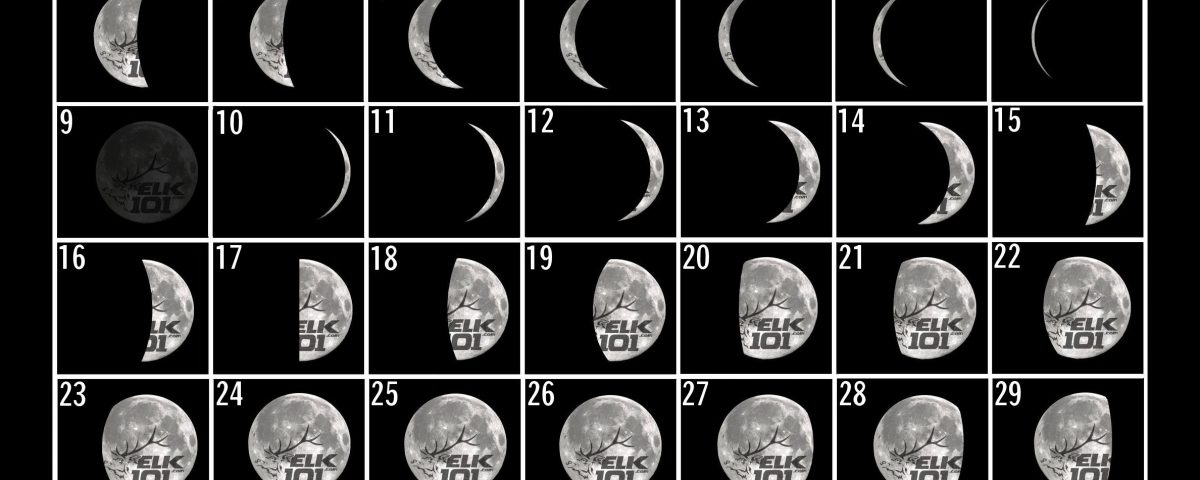
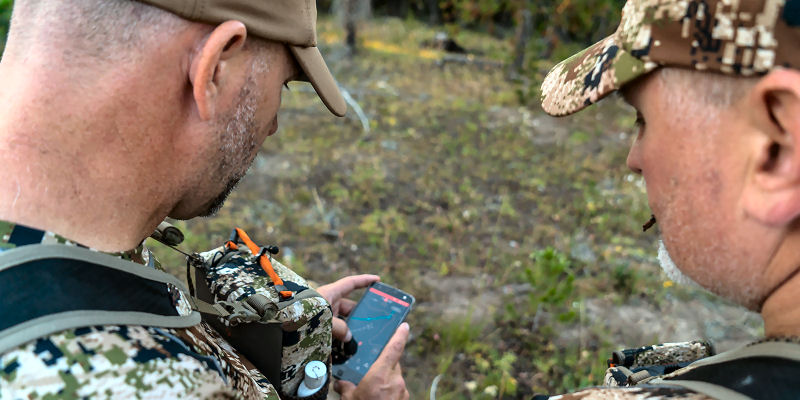
It’s hard to believe we’re already into the month of March! That means elk season is less than 6 months away! It also means that application season is well underway, and plans for the 2018 elk season are falling into shape for many elk hunters. If you haven’t locked in your plans for the 2018 elk season, now is the time. And here are three excellent resources to help you plan your 2018 elk seasons:
- Moon Phases 2018 – Selecting the Right Week
- Which state(s) to apply in for elk
- An INSIDER membership to GoHunt.com
1. What Moon Phase is Best for Elk Hunting?
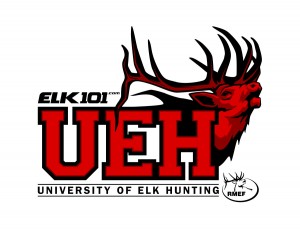 The full article referenced below can be found in the recently updated University of Elk Hunting Online Course – Module 11: Common Challenges – Chapter 1: Frustrations. To sign up for the UEH Online Course and access over 40 Chapters of elk hunting content to help you plan for and succeed on your next elk hunt, CLICK HERE. And feel free to use the discount code ‘FORUMS10’ to save $10 when you sign up!
The full article referenced below can be found in the recently updated University of Elk Hunting Online Course – Module 11: Common Challenges – Chapter 1: Frustrations. To sign up for the UEH Online Course and access over 40 Chapters of elk hunting content to help you plan for and succeed on your next elk hunt, CLICK HERE. And feel free to use the discount code ‘FORUMS10’ to save $10 when you sign up!
As elk hunters, we don’t always have the luxury of hunting during the “prime” week. We are often forced to adapt to whatever moon phase happens to exist on the days we are able to hunt. However, if you are able to pick the “best” week to hunt elk, it’s important to understand how the moon might play a part.
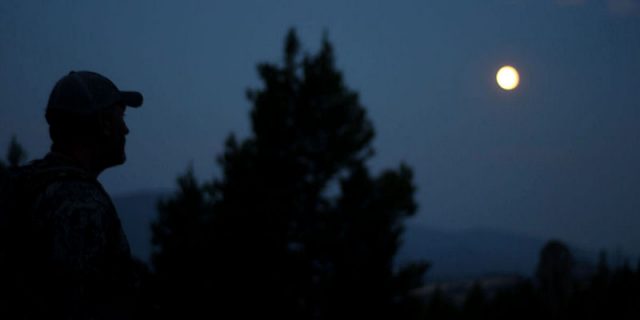 Backing up just slightly, I want to mention one other factor to consider. The amount of light entering a cow elk’s pupil is what triggers the estrus cycle, or the “rut”. Of course, not all cows come into heat at the same time. The older cows usually start first, with the younger cows coming into estrus later. However, cows are generally triggered to come into estrus (and cause the peak rut period) within 5-10 days of the Fall Equinox. The Fall Equinox is when the day and night are of equal duration, and for 2018, the Fall Equinox occurs on September 22nd. So, if you’re looking for the peak rutting “action”, the 17th-27th of September should get you close.
Backing up just slightly, I want to mention one other factor to consider. The amount of light entering a cow elk’s pupil is what triggers the estrus cycle, or the “rut”. Of course, not all cows come into heat at the same time. The older cows usually start first, with the younger cows coming into estrus later. However, cows are generally triggered to come into estrus (and cause the peak rut period) within 5-10 days of the Fall Equinox. The Fall Equinox is when the day and night are of equal duration, and for 2018, the Fall Equinox occurs on September 22nd. So, if you’re looking for the peak rutting “action”, the 17th-27th of September should get you close.
Again, I prefer to hunt before the peak of the rut, but to find the perfect dates, I also need to consider what the moon is going to be doing during this time as well.
In 2018, there will be full moons on August 26, September 25, and October 24. For September, this means that the moon will be mostly dark at the beginning of the month from September 1st through about the 15th. So, I can break September into three sections to evaluate when I want to hunt.
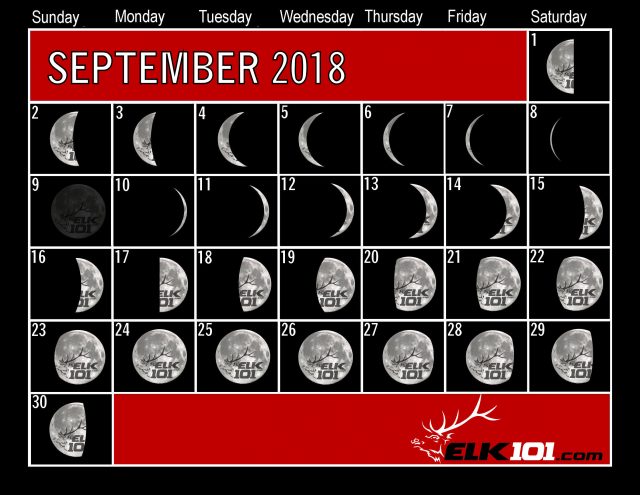
For early season hunting tactics, including finding mature bulls away from the herds, I would target the dates between the 1st and the 9th. There won’t be very much moonlight, which will be a good thing if it is coupled with warmer weather and limited rutting action that is common during early September. Early season hunting can be productive, and 2018 will definitely be a great year for hunting earlier in the month from a moon-phase standpoint.
Jumping ahead to the next 2-3 weeks, there are going to be some prime elk hunting dates during Week #2 (September 9 – 15). This week will provide a great opportunity to get into bulls just as they are starting to establish harems, which can mean some really aggressive bugling and call-ins. This, coupled with a great moon phase, should be an incredible week of elk hunting action.
As we transition into the next week, the hunting action should remain good. Many of the herds will be established and the rutting/bugling action should be incredible as we lead right into the Fall Equinox (September 22nd). The moon will be starting to run towards Full Moon during this week, but it will still be a good week to hunt elk.
During the last week of September (23-30th), the rut will still be going strong, but it will be getting increasingly more difficult to pull herd bulls away from their cows. This coupled with a Full Moon week could make for a tough week of hunting, especially from a calling standpoint. While 2018 won’t provide a great peak-rut/moon phase combination, the 2nd and 3rd weeks should be really, really good.
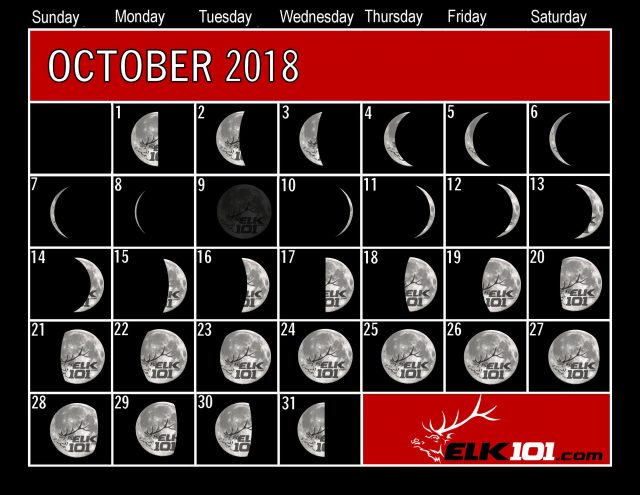 The rifle seasons in many states open during mid-October, so it’s important to recognize that in 2018, the moon will be pretty dark during the 1st half of the month. A full moon hitting on October 24th might give the elk a little more of an opportunity to be less visible during daylight hours, which can make for slower rifle hunting. During these Full Moon days, midday hunting can be really good as the bulls will often get up to stretch their legs. Don’t head back to camp too early on these days.
The rifle seasons in many states open during mid-October, so it’s important to recognize that in 2018, the moon will be pretty dark during the 1st half of the month. A full moon hitting on October 24th might give the elk a little more of an opportunity to be less visible during daylight hours, which can make for slower rifle hunting. During these Full Moon days, midday hunting can be really good as the bulls will often get up to stretch their legs. Don’t head back to camp too early on these days.
As we transition into November, the moon will again be waning and going dark, so early November might be a good time to start catching more elk feeding for longer periods of time during daylight hours. This, coupled with colder weather, might provide more opportunities to catch elk in open areas during legal shooting light. Elk will be transitioning from the post-rut to late-season behaviors during this time as well, but the lack of moonlight will be our friend and hold the elk in feeding areas a little longer in the mornings and a little earlier in the evenings. As with any post-rut and late-season elk hunting, target primary feed sources that the elk will be concentrating on. And for more info specific to hunting the Post-Rut and Late-Season, be sure to check out the newly added Module 15 by Randy Newberg in the University of Elk Hunting Online Course!
From my experience, hunting the days after a full moon as it leads up to a new moon has consistently held the best huntable bugling action. If that phase also happens to land during the days leading up to the peak rut, even better (think 15th – 24th of September). Don’t sell yourself short though, midday hunting during a brighter moon can be pretty insane. Understanding the effects of the moon phase on the elk rut can help you plan when to hunt, but also help you understand how to hunt as well.
2. What State Should I Apply In For Elk?
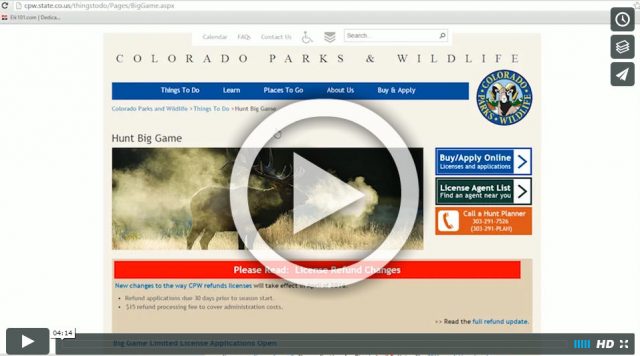 Again, the University of Elk Hunting Online Course is a GREAT resource for planning your elk hunt. A breakdown of the application processes – including how-to-apply videos – is available for all 10 of the Western Elk Hunting States. The application period for the states of Wyoming, Arizona, and Utah are all closed now, and Montana, New Mexico, and Colorado are just around the corner. Having a solid plan for applying for out of state hunts can be a great way to increase your opportunities and elk hunting experience.
Again, the University of Elk Hunting Online Course is a GREAT resource for planning your elk hunt. A breakdown of the application processes – including how-to-apply videos – is available for all 10 of the Western Elk Hunting States. The application period for the states of Wyoming, Arizona, and Utah are all closed now, and Montana, New Mexico, and Colorado are just around the corner. Having a solid plan for applying for out of state hunts can be a great way to increase your opportunities and elk hunting experience.
Personally, I build points in 3-4 states and hope to draw a quality elk tag every 3-4 years (expecting that 10-12 points will get me a quality elk tag in states like Arizona, Nevada, Oregon, Utah, etc.). The number of points needed to draw a quality tag in these states continues to creep upward, but with some research and thinking outside the box, it is definitely possible. If drawing a quality tag isn’t in the plans for a particular year, I look at states and units I might be able to draw with fewer or no points (Montana, Wyoming, Idaho, Oregon, New Mexico, etc.). Fortunately, the draw results from many states are available soon enough that it still leaves time to apply in others if I’m not successful. Ultimately, if I don’t draw any controlled hunt tags, I have a couple states that offer Over-the-Counter elk tags available, and will fill in with those tags as needed.
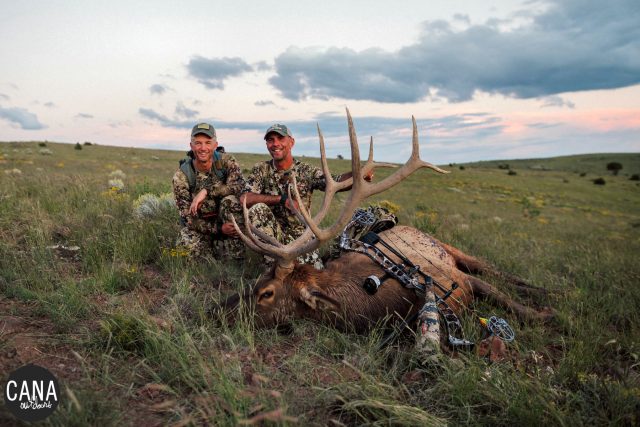 My schedule for September usually includes a draw hunt (easy to draw most of the time, with a quality draw every 3-4 years), and an OTC/general tag, giving me two opportunities to chase elk. This schedule takes planning, and multiple scenarios of back-up plans as the draws are usually far from guaranteed. I know that applying for out of state hunts isn’t for everyone, but it doesn’t have to be as expensive as you might think. In fact, there are states where you can buy points each year for a minimal cost, and build those points until you are ready to apply and draw. I break down the costs, processes, and potential for applying in each of the 10 Western Elk Hunting states in great detail in the UEH Online Course, but if cost is your hurdle in applying out of state, you might be surprised at the opportunities that are out there. However, 75% of my hunts are on OTC/general tags which can usually be purchased with minimal planning and no points.
My schedule for September usually includes a draw hunt (easy to draw most of the time, with a quality draw every 3-4 years), and an OTC/general tag, giving me two opportunities to chase elk. This schedule takes planning, and multiple scenarios of back-up plans as the draws are usually far from guaranteed. I know that applying for out of state hunts isn’t for everyone, but it doesn’t have to be as expensive as you might think. In fact, there are states where you can buy points each year for a minimal cost, and build those points until you are ready to apply and draw. I break down the costs, processes, and potential for applying in each of the 10 Western Elk Hunting states in great detail in the UEH Online Course, but if cost is your hurdle in applying out of state, you might be surprised at the opportunities that are out there. However, 75% of my hunts are on OTC/general tags which can usually be purchased with minimal planning and no points.
If you are interested in accruing points and applying for out of state hunts (based on cost versus potential), here are the top 4 states I recommend looking at:
- Arizona
- Nevada
- Wyoming
- Montana
And that brings me to the last resource I personally use for planning my elk hunts…
3. An INSIDER membership at GoHunt.com
I know…one more thing to pay for. I signed up for a membership to GoHunt INSIDER 2 years ago, and I will honestly say that if you are looking at applying for out of state hunts, it is worth every penny. In fact, both hunts that I went on in 2016 (one OTC and one draw), as well as my out-of-state hunt in 2017, were a direct result of research I did on GoHunt.com. You can enter multiple factors that you want in an elk hunt, and their system will filter the options and provide you with recommended units in each state. For instance, if I want to see which units in Arizona will allow me to hunt the early archery season and have a chance at 330″ bull, and I want to know which of those units I have a 25% chance of drawing with 6 points, it will show me.
Here is a quick video overview of how it works (and a special offer if you sign up):
If you decide that a membership to GoHunt INSIDER is for you, I have teamed up with GoHunt.com to offer you a special deal. Simply CLICK HERE (or click the banner below) and sign up for a membership to INSIDER using the code ‘ELK101’, and we’ll send you a free $50 gift card to use in the Elk101 Store on your next purchase of Elk Hunting Gear!
With resources like GoHunt.com, the University of Elk Hunting Online Course, and the articles and information found here on Elk101.com, you have everything you need to plan your next successful elk hunt. Elk season will be here before we know it….now’s the time to get started! Good luck in 2018!
Leave a comment below and let us know which week you’ll be chasing elk this fall….


